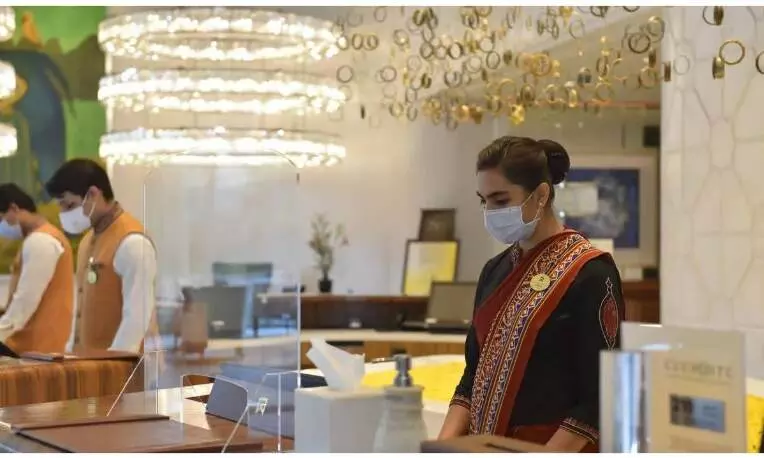Indian hotels set for 11-13% revenue growth next fiscal
The hotel market is inching towards eco-friendly and sustainable practices
image for illustrative purpose

The country’s hotel industry is poised for a healthy revenue growth of 11-13% in the next fiscal after a strong 15-17% growth in the current fiscal, backed by steady domestic demand and ramp up in foreign traveller demand. The strong demand dynamics along with modest new supply will keep the operating performance of the industry healthy over the near term.
The hotels market is expected to witness a rise in revenue with a projected value of $ 9.13 bn this year. The market is expected to exhibit an impressive annual growth rate of 5.41% (CAGR 2024-2028), contributing to a market volume of $ 11.27 bn by 2028.
Additionally, the number of users is expected to reach 64.74 m by 2028, with a user penetration of 3.8% in 2024, which is expected to increase to 4.3% by 2028. The average revenue per user (ARPU) is expected to be $ 167.80.
Moreover, it is projected that 61% of the total revenue in the hotels market will come from online sales by 2028. In comparison, United States is likely to generate the most revenue, with a projected value of $ 110,500 m this year.
India's hotel market is experiencing a shift towards eco-friendly and sustainable practices to cater to the growing demand for responsible tourism.
The healthy operating performance will augur well for the industry profitability where the earnings before interest, taxes and depreciation (Ebitda) will continue the strong momentum over the current and the next fiscal. This, along with limited capital expenditure, will keep the credit profiles strong. A CRISIL Ratings analysis of branded hotel companies with ~70,000 rooms across categories, indicates as much.
Anand Kulkarni, Director, CRISIL Ratings, says “The domestic travel demand, which remained a key driver this fiscal, will sustain next fiscal as well. This momentum will be supported by healthy economic activity which drives business demand and continuing leisure travel demand which reinvigorated post the pandemic. While the demand will remain strong, the growth rate is expected to taper off next fiscal due to high base. Consequently, the average room rates (ARRs) are expected to grow 5-7% next fiscal against 10-12% this fiscal and the occupancy is expected to remain healthy at current levels of 73-74%.”
On the other hand, foreign tourist arrivals in India, despite a growth this fiscal, are estimated to remain ~10%1 below pre-pandemic level. The pick-up and fillip to the demand will be in the next fiscal.
Apart from the aforementioned factors, demand in the MICE (meetings, incentives, conventions and events) segment is also expected to remain healthy as corporates have resumed their activities post-Covid. Moreover, a favourable supply situation is one of the critical drivers of the industry’s strong performance.
According to Nitin Kansal, Director, CRISIL Ratings, “Greenfield capex is expected to remain muted with the new room addition remaining at 4-5% per fiscal over the next couple of years. While the demand rebound has boosted the industry sentiments, the cost dynamics still remain a constraining factor for new capex. High land costs, sizeable increase in construction costs, long gestation period coupled with cyclicality in the sector is resulting in cautious new capex in the sector. Therefore, brands may keep adding rooms through management contracts, which will limit their upfront capital costs.”
The ARR-driven revenue growth typically translates into better profitability, given that operating costs do not increase proportionately. Plus, hotels undertook several cost-efficiency measures like better manpower planning and optimisation in food and beverage expenses, in the last two fiscals. While costs are expected to inch up gradually, operating leverage will help maintain strong operating profitability at 32-33% over the current and the next fiscal — similar to last fiscal and ~1,000 bps higher than the pre-pandemic level.
In this milieu, credit profiles of the hotel companies will continue to improve. For instance, interest coverage is expected to rise to ~4.3 times and ~5.5 times this and next fiscal, which will be ~3.2 times higher than the last fiscal. The debt to Ebitda ratio is seen improving to ~2.2 times this fiscal followed by below two times in the next from last fiscal’s ~2.9 times.
While all the ingredients of the sectors are poised for sustained growth over the near to medium term, any economic slowdown and its impact on business travel, especially on a global scale, will bear watching.
Foreign tourist arrivals are expected to be at 9.5-9.8 million this fiscal against 7.9 million last fiscal and 10.6 million in fiscal 2019.

